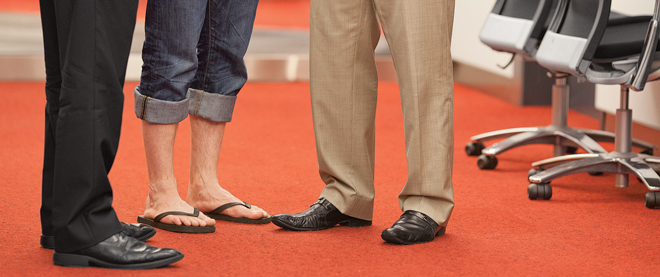
Ancient Egyptians wore them. So did the early peoples of South America, Africa, India, Asia and pretty much everywhere else the weather is pleasant year-round. But should you be wearing them right now? Not if you’re reading this at work.
The flip-flop—a flat sole with a thong grasped between the big and second toe—has provided basic footwear throughout history and seems increasingly popular across Canada today. Perhaps a bit too popular. Nothing stirs debate like the office flip-flop flap.
First some history. According to Elizabeth Semmelhack, senior curator at the Bata Shoe Museum in Toronto, the modern flip-flop entered Western culture during the U.S. occupation of Japan, when soldiers were exposed to traditional zori sandals. As one of Japan’s first postwar exports, the rubber zori was initially marketed to North American housewives and children as a cheap and convenient substitute for slippers. Simultaneous with its role in the suburban lifestyle, the sandal also appeared as part of California surfer culture. “Out of all this, the flip-flop emerges as a symbol of leisure, youth, vacation and play,” says Semmelhack. And it stayed at the beach and in backyards for decades . . . until the 1990s and the rise of casual Fridays.
With the relaxation of dress codes on Fridays, flip-flops followed the path of sneakers, shorts and T-shirts into offices everywhere. The result has been a rapid decline in the formality of office wear throughout the workweek. With summer a precious commodity in Canada, Semmelhack figures the office flip-flop is a way for wearers to squeeze maximum enjoyment out of too few warm months, and to make a personal statement about their commitment to leisure off-hours.
But regardless of a wearer’s intent, Semmelhack, who has written several books on the societal significance of shoes, says the office sandal sends an unmistakable message to everyone else. “Flip-flops say you’re not fully engaged in the business environment,” she observes. “You’ve got one foot in the office and one foot on the beach. It makes a very loud statement about casualness.” Very loud indeed. “There’s also the aggravating noise they make—flip-flop-flip-flop—and that can be very distracting,” she adds.
There is some recent evidence of a fight back in the name of formality. Last year, Renfrew County in Ontario declared its offices a flip-flop-free zone to improve the municipality’s image. Major League Baseball did the same thing beginning this season, banning flip-flop-wearing reporters from the press box. And in a survey released by human resources firm Adecco Staffing, flip-flops were identified as the number one “summer wardrobe offender” for men and women, with 71 per cent of respondents saying they’re inappropriate for the workplace. Finally, while IBM abandoned its famously strict dark-suit-and-white-shirt dress code in 1995, flip-flops remain forbidden at its offices, and those of countless other firms adhering to any reasonable definition of “business casual.”
Besides the threat to workplace seriousness, flip-flops also entail significant health risks. In a blog post this month, Dr. Steven Weinfeld, chief of foot and ankle surgery at Mount Sinai School of Medicine in New York City, warned that flip-flops can become your foot’s arch-enemy. “They don’t offer your foot any support or protection, so it’s like you’re walking barefoot, which can lead to sore arches.” Further, gripping the thong with your toes disrupts your foot’s natural stride, leading to strained hips, knees and ankles. Not to mention stubbing your toes on the filing cabinet.
Then again, some employers seem to welcome the slacker image associated with flip-flops. Last month, for example, Chicago-based online recruiter CareerBuilder was rated second on a list of the 100 best places to work in information technology. In bragging about this achievement, the firm sent out a press release touting its “casual dress code where flip-flops and shorts are the norm.”
So is the flip-flop really appropriate workwear? Sure. If you happen to work in a cabana, or at some rebellious, hipster high-tech firm. Otherwise, do yourself and everyone else a favour and slip on something a bit less comfortable.